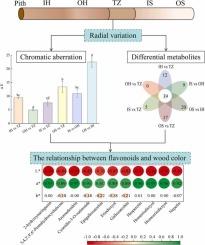Industrial Crops and Products ( IF 5.6 ) Pub Date : 2024-06-27 , DOI: 10.1016/j.indcrop.2024.119021 Ting Jia , Kefei Liu , Yini Li , Qiangqiang Cheng , Wen Cao , Hai Luo , Jikai Ma , Lu Zhang

|
Radial chromatic aberration (∆E) in xylem is a significant phenotypic characteristic for distinguishing sapwood from heartwood. Investigating its relationship with metabolites is critical to the formation of color differences in wood. In this study, chromatic aberration of the inner heartwood (IH), outer heartwood (OH), transition zone (TZ), inner sapwood (IS), and outer sapwood (OS) were quantified utilizing the CIE color space system, and the secondary metabolite profiles of Toona fargesii wood were identified. The findings showed a radial variation in the wood color of T. fargesii. The chromatic aberration was largest in the OS vs. IH for 22.51 and smallest in OH vs. TZ for 4.92. A total of 646 metabolites from 8 categories were obtained from wood, including flavonoids, phenolic acids, terpenoids, et al. The OS vs. IH had the highest number of differential metabolites with 395, whereas the OH vs. TZ had the fewest differential metabolites with 184. The metabolites were mostly enriched in metabolic pathways and the biosynthesis of flavonoids. The 75 % metabolites in the flavonoid biosynthesis pathway were abundant in HW tissues and gradually decreased from IH to OS. There were 39 shared differential metabolites among six comparison groups, of which flavonoids accounted for 31 %. There were clear radial differences in the flavonoid metabolites, with a generally decreasing trend from IH to OS tissue. The relative content of the flavonoids exhibited negative and positive correlations with L* and a*, respectively. Especially the largest correlation coefficients for 93 % between 2-hydroxynaringenin, aromadendrin and L* showed their importance in chromatic aberration. This study demonstrated the radial variation pattern of chromatic aberration and metabolic profiles. It also identified the key metabolites that affect wood color in T. fargesii, which offered valuable insights into the formation of the chromatic aberration in wood.
中文翻译:

差异代谢物调控香椿木材色差的形成
木质部的径向色差(ΔE)是区分边材和心材的重要表型特征。研究其与代谢物的关系对于木材色差的形成至关重要。在本研究中,利用 CIE 色彩空间系统对内心材 (IH)、外心材 (OH)、过渡区 (TZ)、内边材 (IS) 和外边材 (OS) 的色差进行量化,并采用二次色差鉴定了香椿木材的代谢谱。研究结果显示,T.fargesii 的木材颜色存在径向变化。 OS 与 IH 的色差最大,为 22.51;OH 与 TZ 的色差最小,为 4.92。从木材中获得黄酮类、酚酸类、萜类化合物等8类共646种代谢物。 OS与IH的差异代谢物数量最多,为395个,而OH与TZ的差异代谢物数量最少,为184个。代谢物大多富集于代谢途径和黄酮类化合物的生物合成。类黄酮生物合成途径中75%的代谢物在HW组织中丰富,并且从IH到OS逐渐减少。 6个对照组共有39种差异代谢物,其中黄酮类化合物占31%。类黄酮代谢物存在明显的径向差异,从 IH 到 OS 组织总体呈下降趋势。黄酮类化合物的相对含量分别与L*和a*呈负相关和正相关。特别是2-羟基柚皮素、芳香素和L*之间的最大相关系数为93%,显示了它们在色差中的重要性。这项研究证明了色差和代谢曲线的径向变化模式。 它还确定了影响 T. fargesii 木材颜色的关键代谢物,这为木材色差的形成提供了宝贵的见解。











































 京公网安备 11010802027423号
京公网安备 11010802027423号